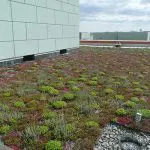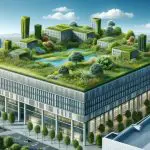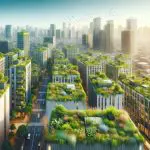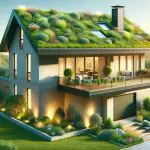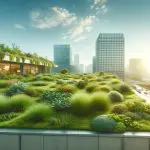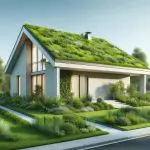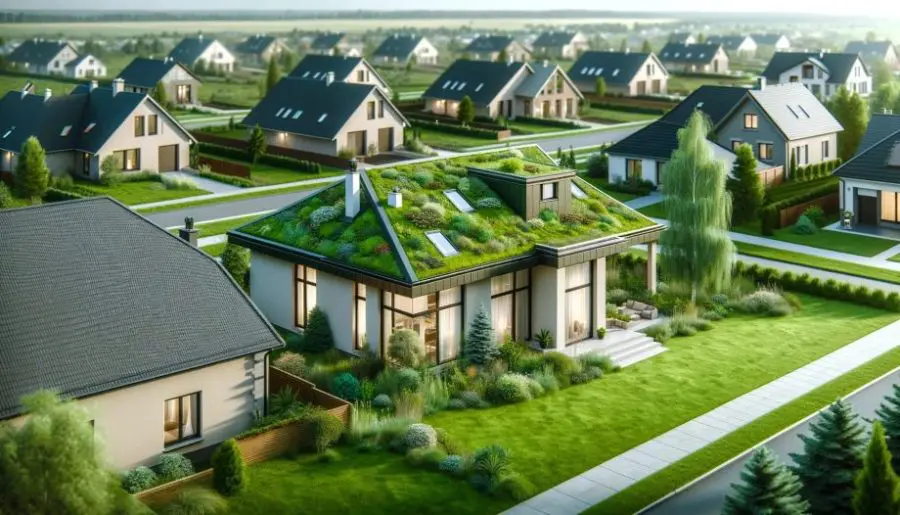
Discover the green roofs pros and cons in our friendly guide. Learn how they benefit urban spaces while understanding their challenges!
Green Roofs Pros and Cons Key Takeaways:
- Green roof pros include environmental benefits like improved air quality and energy efficiency
- Cons are challenges such as higher installation costs and maintenance requirements.
- They offer aesthetic appeal and support biodiversity but require structural adaptations for installation.
Are you curious about the pros and cons of green roofs? You’re in the right place!
Join us as we dive into the world of green roofs, exploring how they’re reshaping urban landscapes with their benefits and challenges.
Let’s start this green journey together!
Green Roofs Pros and Cons
Welcome to the fascinating world of green roofs! Today, we’re delving into the ‘green roofs pros and cons,’ a topic that’s buzzing in urban sustainability circles.
Green roofs aren’t just about adding a splash of green to our concrete jungles; they’re about revolutionizing the way we view our urban spaces.
From energy efficiency to creating wildlife habitats, we’ll explore the numerous benefits these eco-friendly rooftops bring to our cities.
So, buckle up and get ready to discover how a layer of green on top can make a world of difference below!
Green Roofs Pros
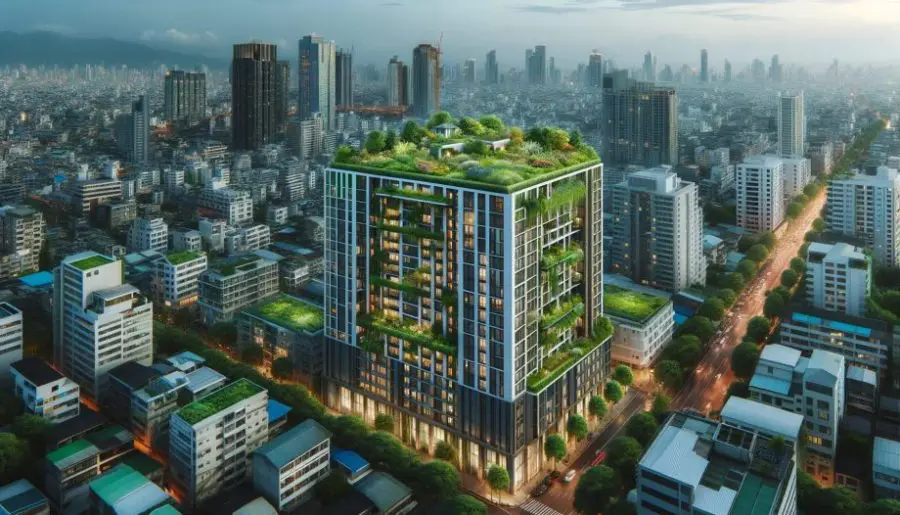
Green roofs, a sustainable and innovative solution in modern architecture, are rapidly gaining popularity across urban landscapes.
These living roofs, adorned with vegetation, offer a harmonious blend of nature and urban development.
Green roofs are not just a visually appealing addition to buildings; they play a crucial role in enhancing environmental sustainability.
By incorporating layers of soil and plants, they transform traditional rooftops into vibrant, green spaces.
This eco-friendly approach is increasingly recognized for its multitude of benefits, ranging from improving air quality to energy efficiency.
As cities become more densely populated, green roofs stand out as a creative strategy to reintroduce nature into urban areas.
Their growing prevalence marks a significant shift towards eco-conscious building practices, demonstrating that functional design can coexist with environmental stewardship.
However, it is important to address both the pros and cons of green roofs so informed decisions can be made. We will start with the pros.
Natural Insulation: A Key Feature of Green Roofs
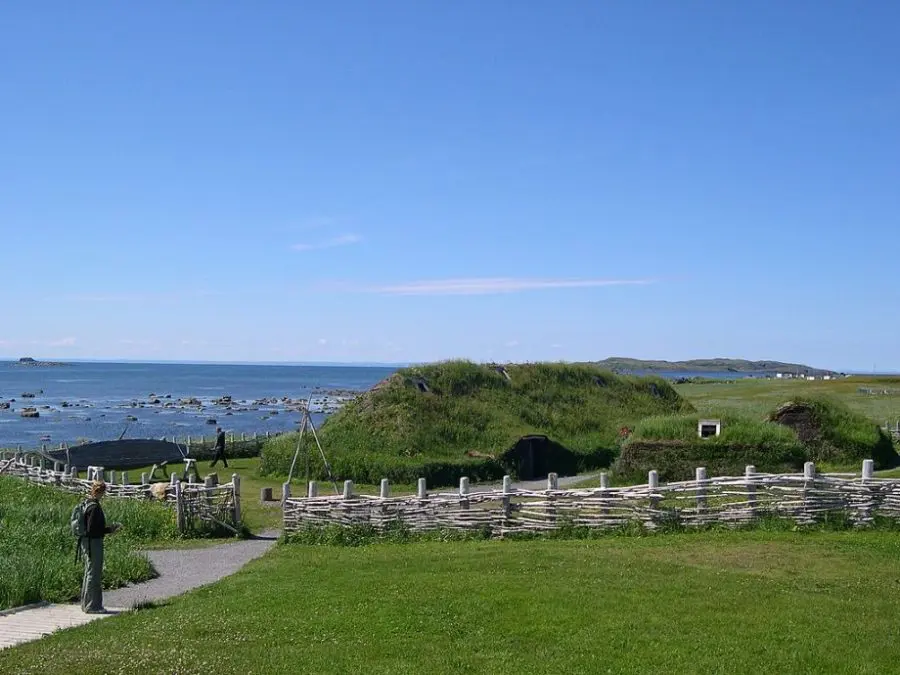
The picture above shows reconstructed Viking homes with green roofs proving temperature moderation with green roofs is not a new idea.
Green roofs are renowned for their natural insulation capabilities, making them a sought-after feature in modern architecture.
This insulation plays a crucial role in both warm and cold climates, providing a buffer against extreme temperatures.
Summer Benefits: Cooling and Energy Savings
During the warmer months, green roofs come into their own by absorbing and deflecting sunlight.
This natural process reduces the internal temperature of buildings, leading to less reliance on air conditioning.
The result is a noticeable decrease in energy costs, showcasing how green roofs work effectively to enhance a building’s energy efficiency.
Winter Advantages: Heat Retention and Reduced Energy Bills
In winter, the benefits of green roofs continue. They act as a thermal blanket, trapping heat and reducing the amount of heat lost through the roof.
This natural insulation means lower heating needs and, consequently, significant savings on energy bills.
Overall Energy Efficiency and Environmental Impact
The role of green roofs in energy efficiency extends to all seasons. They not only improve a building’s temperature regulation but also contribute to broader environmental benefits.
By reducing the need for artificial heating and cooling, green roofs make a substantial contribution to energy conservation and sustainability in urban areas.
Comfort and Temperature Regulation through Green Roofs
Let’s talk about Comfort and Temperature Regulation through Green Roofs!
Ever wondered how a layer of greenery on your roof can transform your home’s comfort levels?
It’s not just about adding a splash of green; it’s about creating a living, breathing thermal regulator right above us.
Join me as we explore the fascinating way green roofs maintain cozy indoor temperatures, no matter the weather outside.
Get ready to discover a world where nature and comfort meet!
Balancing Indoor Temperatures Naturally
Green roofs play a pivotal role in maintaining a stable and comfortable indoor climate.
Their natural composition, comprising vegetation and soil, acts as a thermal regulator.
This unique feature is particularly beneficial in areas experiencing extreme weather conditions.
Summer Comfort: Mitigating Heat
During hot summer days, green roofs absorb heat, preventing it from permeating into the building.
This natural process helps in keeping indoor spaces cooler and more comfortable, reducing the need for constant air conditioning.
It’s a practical demonstration of how green roofs work to create a more pleasant living or working environment.
Winter Warmth: Reducing Heat Loss
Conversely, in colder months, green roofs contribute to retaining warmth inside the building.
The vegetative layer minimizes heat escape, ensuring indoor spaces remain warm without excessive heating.
This efficient temperature regulation is essential in maintaining year-round comfort while also being energy efficient.
Environmental Benefits: Air Quality and CO2 Absorption
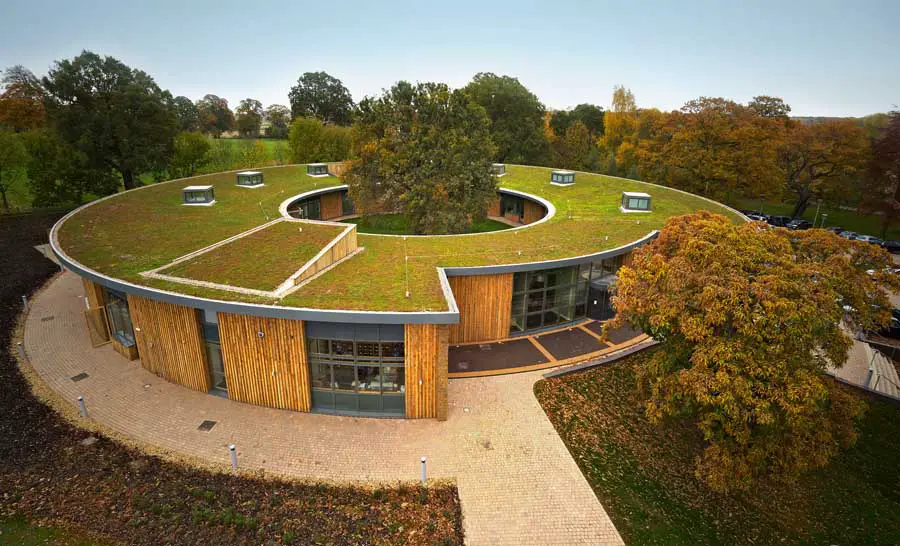
In the pursuit of sustainable urban development, green roofs emerge as a pivotal solution in enhancing environmental health.
They stand at the intersection of architecture and ecology, offering far more than aesthetic appeal.
Central to their environmental impact is the significant improvement in air quality and the effective absorption of CO2.
This section delves into how green roofs contribute to cleaner air and reduced carbon emissions, underlining their role in addressing some of the most pressing environmental challenges of our time.
Enhancing Urban Air Quality
Green roofs play a significant role in improving air quality, especially in densely populated urban areas.
The plants and soil on green roofs act as natural filters, absorbing pollutants and particulate matter from the air.
This process leads to a noticeable improvement in the air quality surrounding the building, creating a healthier environment for residents and the community.
Carbon Dioxide Absorption and Climate Mitigation
Another crucial environmental benefit of green roofs is their ability to absorb carbon dioxide, a major greenhouse gas.
The vegetation on green roofs takes in CO2 during the photosynthesis process, effectively reducing the overall carbon footprint of the building.
This absorption is particularly significant in urban centers, where CO2 emissions are typically high due to traffic and industrial activities.
Contributing to Sustainability Goals
The combined effect of improved air quality and CO2 absorption by green roofs aligns perfectly with broader environmental sustainability goals.
These roofs not only provide immediate benefits to building occupants but also contribute to the global effort of combating climate change.
Green roofs are a practical embodiment of how innovative architectural design can lead to environmental benefits, including a reduction in urban heat islands and enhanced ecosystem services.
Supporting Urban Wildlife and Biodiversity
Green roofs are not just architectural enhancements; they are vital oases for urban wildlife and biodiversity.
In cities, where natural habitats are often scarce, these green spaces become crucial sanctuaries for a variety of species.
The vegetation on green roofs provides food, shelter, and breeding grounds for insects, birds, and even small mammals.
This biodiversity is especially important in urban settings, where ecological systems are frequently disrupted by development and pollution.
Green roofs can help to mitigate these effects by offering alternative habitats, thus contributing to the conservation of urban wildlife.
Additionally, they serve as stepping stones for species to move and interact within urban landscapes, enhancing ecological connectivity.
The presence of diverse plant life on green roofs not only supports various species but also helps to maintain ecological balance.
By introducing these pockets of nature into urban areas, green roofs play a critical role in sustaining and enriching urban ecosystems.
Creating Urban Sanctuaries for Wildlife
Green roofs act as vital sanctuaries for urban wildlife, offering a much-needed respite in the concrete jungle.
They provide a haven where a variety of species, from insects to birds, can thrive.
This is especially crucial in urban areas where natural habitats are increasingly rare.
Enhancing Ecological Connectivity
These green spaces not only support individual species but also play a key role in enhancing ecological connectivity.
They allow different species to move and interact within the urban environment, fostering a more dynamic and interconnected ecosystem.
Contributing to Biodiversity
The diverse plant life on green roofs contributes significantly to urban biodiversity.
By introducing these pockets of nature into cityscapes, green roofs help maintain ecological balance, making urban areas not just more livable for humans, but also more hospitable for a range of wildlife species.
Enhanced Aesthetic Appeal and Property Value
Green roofs are transforming urban landscapes, not just environmentally, but also aesthetically.
They bring a refreshing change to the monotonous concrete skyline, adding a touch of greenery that is both pleasing to the eye and beneficial to the environment.
This section explores how green roofs enhance the visual appeal of buildings and potentially increase property value.
Visual Appeal: A Touch of Nature
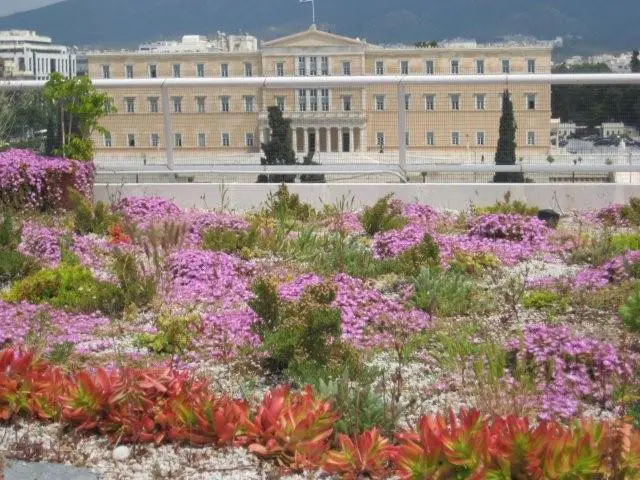
The lush greenery of roof gardens provides a stark contrast to the usual urban backdrop of concrete and steel.
This visual appeal can significantly enhance the overall look of a building, making it stand out in an urban environment.
It’s not just about the greenery; the design possibilities with green roofs are vast, allowing for creative expression and architectural innovation.
Boosting Property Value
Beyond aesthetics, green roofs can also have a positive impact on property value.
They are increasingly seen as a desirable feature in real estate, appealing to eco-conscious buyers and tenants.
The combination of environmental benefits and aesthetic appeal makes properties with green roofs more attractive in the market.
A Symbol of Sustainability
Incorporating green roofs is often viewed as a symbol of sustainability and forward-thinking design.
This not only improves the image of the property but also reflects positively on the values of the occupants or owners, aligning with the growing trend towards environmentally responsible living.
Green Roofs Cons
While green roofs offer a plethora of benefits, it’s essential to also consider the challenges and drawbacks associated with them.
In this section, we’ll delve into the cons of green roofs, examining aspects such as their installation and maintenance costs, structural requirements, and potential limitations.
Understanding these downsides is crucial for anyone considering the implementation of a green roof, ensuring a well-rounded perspective on what to expect.
This balanced view not only helps in making informed decisions but also in planning for the effective management of green roofs.
The High Cost of Installation and Maintenance
Embarking on the journey of installing a green roof brings with it significant financial considerations.
This investment is not just a one-time expense but extends to ongoing maintenance costs.
In this section, we explore the financial implications of green roofs, both in terms of their initial installation and the continual upkeep they require.
Understanding these costs is crucial for anyone considering a green roof, as it impacts the long-term feasibility and sustainability of this eco-friendly option.
By delving into these aspects, we aim to provide a clear picture of what financial commitment is involved in bringing a green oasis to urban rooftops.
Understanding the Financial Implications
Implementing a green roof is a significant investment, both in terms of initial installation and ongoing maintenance.
This section addresses the financial aspects of green roofs, helping potential implementers understand the costs involved.
Initial Installation Costs
The initial cost of installing a green roof can be considerably higher than that of a traditional roof.
This is due to the need for specialized materials such as waterproof membranes, drainage layers, soil substrates, and a variety of plants.
Additionally, the installation process itself can be more complex and labor-intensive, contributing to higher overall costs.
Ongoing Maintenance Expenses
Apart from installation, maintaining a green roof requires consistent effort and resources.
Regular tasks such as watering, weeding, fertilizing, and ensuring proper drainage can add up in terms of time and money.
While some maintenance can be done independently, larger or more complex green roofs may require professional services, further adding to the expense.
Balancing Cost with Long-term Benefits
It’s important to balance these costs against the long-term benefits green roofs offer.
While the upfront and maintenance costs are higher, green roofs can lead to energy savings, increased property value, and longer roof lifespans, which may offset the initial investment over time.
Making an Informed Decision
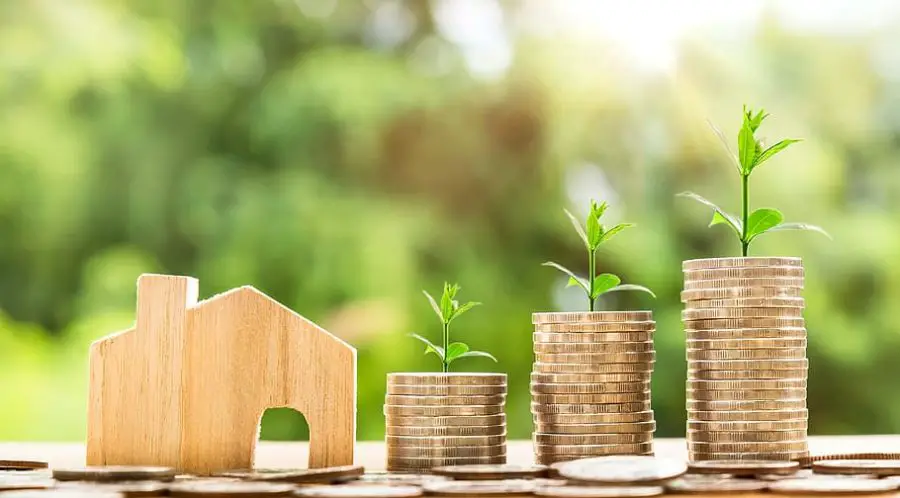
Prospective green roof owners should carefully consider these financial aspects to make an informed decision.
Understanding the full scope of investment required can help in planning and budgeting for a green roof that meets both environmental goals and financial constraints.
Structural Requirements and Modifications
When contemplating the addition of a green roof to a building, one must not overlook the critical structural requirements and necessary modifications that come with it.

In the picture above we see a roof in Hong Kong that collapsed because of the critical structural requirements and necessary modifications that were not made.
In this segment, we focus on the essential structural considerations that underpin the successful installation of a green roof.
From assessing the additional weight load to making necessary architectural adjustments, this part of the process is as crucial as it is complex.
Understanding these requirements is key to ensuring the safety, longevity, and effectiveness of a green roof, making it a vital component of the planning and implementation phase.
Addressing the Need for Enhanced Structural Support
The implementation of a green roof is not just a matter of planting vegetation atop a building.
It requires careful consideration of the structural integrity of the existing roof.
This section delves into the necessary structural requirements and modifications needed to support a green roof.
Assessing Weight Load and Stability
A primary concern with green roofs is the additional weight they bring.
The combination of soil, plants, and retained water significantly increases the load on the building’s structure.
This necessitates a thorough assessment of the roof’s ability to support this extra weight.
In many cases, structural reinforcements or modifications are required to ensure stability and safety.
Retrofitting for Green Roofs
Especially in older buildings, retrofitting can be a crucial step in preparing for a green roof installation.
This process might involve strengthening the roof’s framework, enhancing load-bearing elements, or even redesigning certain sections of the roof.
Such modifications, while necessary, add to the complexity and cost of the project.
Navigating Building Codes and Regulations
Installing a green roof also means navigating various building codes and regulations, which can differ significantly from one region to another.
Ensuring compliance with these regulations is essential and might require professional consultations, further adding to the project’s complexity and cost.
Long-term Structural Considerations
Finally, long-term structural considerations are crucial for maintaining the integrity of the green roof.
Regular checks and maintenance of the roof’s structure are important to prevent issues such as water damage or structural weakening over time.
Maintenance Challenges and Efforts
The allure of a lush, green rooftop garden is undeniable, but it’s important to recognize that maintaining this verdant space requires more than just an occasional glance.
In this section, we delve into the maintenance challenges and efforts that are integral to the health and longevity of green roofs.
Addressing these maintenance needs is crucial, as it directly impacts the functionality and aesthetic value of the roof.
From routine tasks to addressing unexpected issues, understanding the full scope of what it takes to upkeep a green roof is essential for anyone considering this eco-friendly roofing option.
Understanding the Maintenance Demands
While green roofs offer numerous benefits, they also come with specific maintenance challenges that cannot be overlooked.
This section will explore the various aspects of maintaining a green roof, highlighting the efforts required to keep these living systems healthy and functional.
Regular Care and Upkeep
One of the key aspects of green roof maintenance is the regular care and upkeep it demands.
This includes tasks such as watering, weeding, and managing the vegetation.
Depending on the size and type of green roof, these tasks can range from relatively simple to quite complex, requiring a significant time commitment or even professional assistance.
Dealing with Environmental Stressors
Green roofs are exposed to various environmental stressors like extreme weather conditions, pests, and potential diseases.
Addressing these challenges requires vigilance and an understanding of horticulture.
Regular inspections and prompt interventions are necessary to ensure the longevity and effectiveness of the green roof.
Ensuring Structural Integrity and Drainage
Maintenance also involves ensuring the structural integrity of the roof and effective drainage.
Neglect in these areas can lead to serious issues like water leakage or structural damage.
Regular checks and maintenance of the drainage system, waterproofing layers, and overall roof condition are crucial for avoiding costly repairs.
Balancing Aesthetics with Functionality
Finally, maintaining a green roof is not just about functionality but also aesthetics.
Ensuring the roof remains visually appealing requires an additional layer of care, particularly in managing plant growth and coverage.
This balance is essential to retain the full range of benefits offered by green roofs.
Limitations and Suitability Concerns
The adoption of green roofs is gaining momentum, but it’s crucial to address the limitations and suitability concerns associated with them.
This segment focuses on understanding where and when green roofs are most effective and appropriate.
While they offer numerous benefits, green roofs are not universally suitable for every building or environment.
Various factors, such as structural integrity, climate conditions, and intended use, play significant roles in determining their feasibility.
By exploring these limitations and suitability concerns, this section aims to provide a realistic perspective on the applicability of green roofs, ensuring that the decision to install one is made with a comprehensive understanding of its potential and constraints.
Evaluating the Feasibility of Different Structures
The concept of green roofs is appealing, but it’s not a one-size-fits-all solution.
This section examines the limitations and suitability concerns that need to be considered when deciding if a green roof is appropriate for a specific building or environment.
Architectural and Structural Limitations
One of the primary concerns is the architectural and structural suitability of a building for supporting a green roof.
Not all structures are designed to bear the additional weight of soil, plants, and retained water.
This is particularly true for older buildings or those with certain architectural styles.
Assessing structural integrity and the potential need for reinforcement is a critical first step.
Climate and Environmental Suitability
The effectiveness of green roofs also depends on the local climate and environmental conditions.
In areas with extreme weather conditions, such as heavy snowfall or intense heat, special considerations and adaptations are necessary.
The choice of plants and the design of the green roof must align with the local climate to ensure sustainability and effectiveness.
Access and Usage Limitations
Accessibility is another factor to consider. Green roofs on high-rise buildings or those with limited access can pose challenges for maintenance and emergency services.
Additionally, the intended use of the roof space, whether for public access, private gardens, or purely environmental purposes, will influence its design and feasibility.
Cost-Benefit Analysis for Different Scenarios
Finally, the decision to install a green roof should involve a thorough cost-benefit analysis.
While the environmental and aesthetic benefits are significant, they must be weighed against the practical and financial implications for each specific case.
This analysis helps in determining the overall suitability and viability of a green roof for a given building or project.
Green Roofs Pros and Cons FAQs
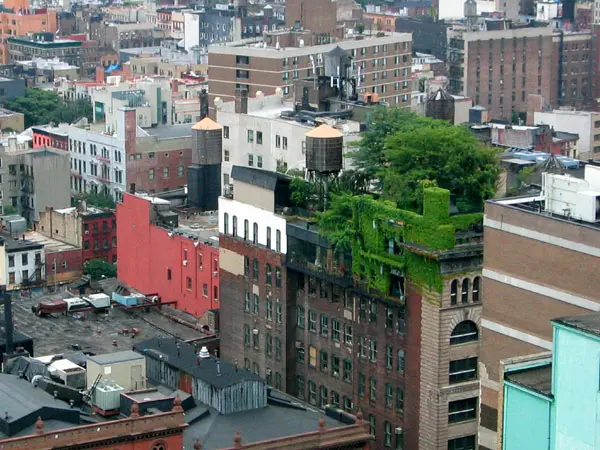
In this section, we address some of the most frequently asked questions about green roofs.
These FAQs aim to provide a clearer understanding of both the benefits and challenges associated with green roofs, helping you make an informed decision about whether they are the right choice for your building.
Q: What are the primary benefits of installing a green roof?
A: Green roofs offer numerous benefits, including improved air quality, energy efficiency, and enhanced building aesthetics. They also support urban biodiversity and can extend the lifespan of your roof.
Q: How do green roofs impact energy consumption and utility bills?
A: Green roofs provide natural insulation, which can lead to reduced energy consumption for heating and cooling, thereby lowering utility bills.
Q: What are the common challenges associated with maintaining a green roof?
A: Maintenance challenges include regular watering, weeding, and managing vegetation. Environmental stressors and ensuring structural integrity are also key considerations.
Q: Can green roofs be installed on any type of building?
A: The suitability of green roofs depends on the structural capacity of the building. Not all buildings can support the additional weight of a green roof without modifications.
Q: How do green roofs contribute to environmental sustainability?
A: By improving air quality, reducing heat islands, and enhancing biodiversity, green roofs contribute significantly to environmental sustainability.
Q: What are the disadvantages of green roofs?
A: Disadvantages include higher installation and maintenance costs, the need for structural modifications, and potential challenges in maintenance.
Q: What is the challenge of green roofs?
A: Key challenges include ensuring adequate structural support, ongoing maintenance requirements, and managing the initial higher costs.
Q: Is a green roof more expensive?
A: Yes, green roofs generally involve higher upfront costs compared to traditional roofs, both in terms of installation and maintenance.
Q: What is the life expectancy of a green roof?
A: With proper maintenance, green roofs can significantly extend the life of a roof, often doubling or even tripling its lifespan.
Q: Do green roofs increase property value?
A: Green roofs can increase property value due to their aesthetic appeal, environmental benefits, and potential energy savings.
Q: What is the biggest limitation to having a green roof?
A: The biggest limitation is often the structural capacity of the building, as not all structures can support the weight of a green roof without modifications.
Q: Are green roofs hard to maintain?
A: The level of difficulty in maintaining a green roof varies based on its size and complexity. Regular maintenance tasks can be demanding, similar to maintaining a garden.
Q: Do green roofs reflect heat?
A: Green roofs primarily absorb and use heat, rather than reflecting it. They help in reducing the overall temperature of the building, contributing to a cooler urban environment.
Green Roofs Pros and Cons A Balanced Perspective: Conclusion
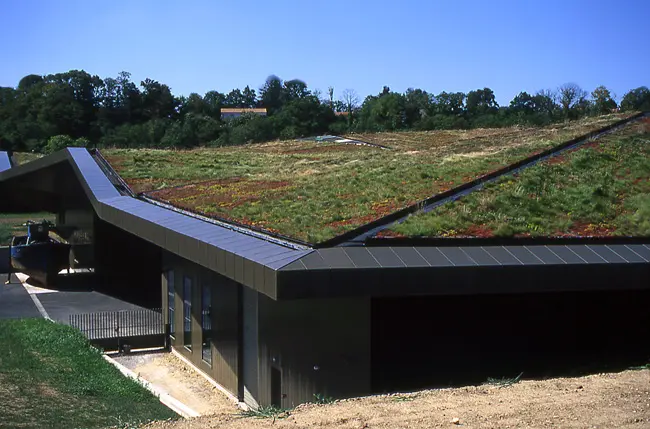
As we conclude our exploration of green roofs, it’s clear that they represent a significant advancement in sustainable urban development.
While green roofs offer an array of benefits, understanding their challenges is equally important.
Learn more: Why do we need green roofs
Let’s recap the key points and considerations to take away from this comprehensive look at green roofs.
Weighing the Benefits Against Challenges
Green roofs are more than just an aesthetic enhancement; they are a testament to environmental responsibility and innovation.
Their ability to improve air quality, enhance biodiversity, and reduce energy consumption is unparalleled.
However, it’s crucial to balance these advantages with the understanding of their higher installation costs, structural requirements, and maintenance needs.
Long-Term Sustainability and Urban Improvement
Despite the challenges, the long-term sustainability and urban improvement offered by green roofs make them a worthwhile investment.
They are a step towards greener, more livable cities, contributing significantly to the mitigation of urban heat islands and the creation of healthier environments.
Making Informed Decisions for the Future
For those considering green roofs, it’s essential to make informed decisions based on a building’s structural capacity, budget constraints, and maintenance capabilities.
The journey towards installing a green roof should be embarked upon with a clear understanding of both its potential and limitations.
In summary, green roofs stand as a shining example of how we can harmoniously integrate nature into our urban landscapes.
They challenge us to rethink our approach to urban development, pushing us towards a more sustainable and ecologically conscious future.

